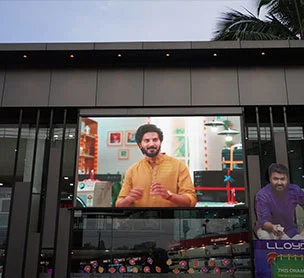- P.O.Box: 31077, Office No:23, Al Emadi Building, Near Hilal Signal, D Ring Road, Doha, Qatar
- [email protected]
Blog Details
Exploring the Different Types of LED Technologies: A Complete Guide

- Posted On 31 Oct 2024
#bestdigitalsignageinqatar #bestledvideowallinqatar #bestdigitalsignagedisplayindoha #topoutdoordigitalsignageinqatar #topoutdoordigitaldisplay #bestoutdoorvideowallinqatar #bestavcompanyinqatar #bestledaudiovisualcompany #topcorporateeventplanningcompany #bestLEDscreensinqatar #bestCustomLEDsolutionscompany #novastar #LEDscreensuppliersinqatar #leddisplayscreenpriceqatar #topindoorrentalleddisplayqatar
LED (Light Emitting Diode) technology has revolutionized the face of displays and lighting to bring high brightness, energy efficiency, and versatility into the world of applications. However, not all LED technologies are created equal! From traditional LED displays to advanced OLEDs, each type brings unique advantages. Here's a breakdown of the main types of LED technologies and their applications.
1. Traditional LEDs (Light Emitting Diodes)
Description: These are the simple LEDs that we have in most electronics to indicate purposes or small-size light sources. They constitute semiconductor materials that emit light when a current passes through them.
Applications: The traditional application of LEDs have been around for a few decades to be used simply as indicator lights, power lighting, and very minimal electronic displays.
Advantages: They are very efficient, extremely durable, but economical to produce. Unfortunately, they are also less bright and colorful in contrast to the more advanced varieties of LEDs.
2. SMD (Surface-Mounted Device) LEDs
Description: SMD LEDs, which are brightly assembled on a PCB or on a Printed Circuit Board are compactly and has energy efficiency. Most extensively used in LED screens and signage
Application: The SMD LEDs have fine visibility and are good for use in digital signboards, video walls that have to be used indoors and outdoors. They are particularly preferred for large displays.
Benefits: SMD LEDs tend to have high brightness; vibrant colors and deliver fairly good resolution. They may even be used for closed as well as far-end viewing.
3. COB (Chip on Board) LEDs
Description: In the COB technology, a number of LED chips are mounted closely on a single board to create a high-density light source. It appears as one uniform light with minimal shadow effects.
Applications: High-intensity lighting, including floodlights, downlights, and outdoor displays.
Advantages: COB LEDs emit more lumen output per square inch and offer a wider, more uniform light, making them best suited for large spaces or applications that require high-intensity light.
4. MicroLED
Description: MicroLED is an advanced technology that uses microscopic LEDs to create ultra-high-definition displays. Each micro-LED is an individual pixel that provides excellent color control and brightness.
Applications: MicroLED technology is receiving acceptance in premium televisions, virtual reality devices, and digital signage.
Advantages: MicroLEDs feature excellent brightness, contrast, and color accuracy with excellent durability and energy efficiency but can be costly to fabricate.
5. OLED (Organic Light Emitting Diodes)
Description: OLEDs emit light from organic material using an electric current. The OLED does not contain a backlight, hence the OLED can be made thin and flexible.
Applications: The OLED technology is now used in most smartphones and high-end televisions because of their high-quality image and rich colors, apart from wearables.
Advantages: OLEDs have deep blacks, high contrast, and vivid colors since each pixel emits its own light. The technology also allows for flexible and ultra-thin designs, but OLEDs are more expensive and can suffer from burn-in over time.
6. QLED (Quantum Dot Light Emitting Diodes)
Description: QLED technology uses a quantum dot layer to enhance the color and brightness of the LEDs. Quantum dots are tiny particles that emit specific colors based on their size.
Applications: Primarily used in televisions and some digital signage, QLED offers a premium viewing experience.
Advantages: QLEDs are very bright, have a wider color gamut, and are long-lasting. That is, they can be used for a very long time, especially in lit-up spaces. Yet, they are still backlight-lit and not OLED.
7. MiniLED
MiniLED technology makes use of smaller LEDs compared to the traditional SMD LEDs. It provides more specific and stronger backlighting source.
MiniLEDs will be more commonly used high-end televisions, monitor, and tablets whose contrast and colors are much better compared to the normal led-lit screens.
Advantages: MiniLEDs have better brightness, contrast, and dimming areas compared to traditional LEDs but are typically more costly.
Choosing the Right LED Technology for Your Application
Each of the LED technologies has its strengths, suitable for particular applications and budgets:
For commercial displays and signage, SMD or COB LEDs are usually the best choice because they are rugged, bright, and cost-effective.
QLED or OLED is the best fit for high-end TVs or professional monitors, depending on the need for brightness or deep contrast.
For applications such as VR, digital wearables, and compact screens, MicroLED and OLED are suitable for leading-edge performance and design flexibility.
With the numerous LED technologies available, it is easier than ever to find the right display solution to suit your needs. This can range from a highly rugged outdoor sign to large video walls or ultra-thin, high-definition TV applications. Understanding these technologies can help make an informed decision, ensuring that the LED display delivers optimal performance for years to come.

